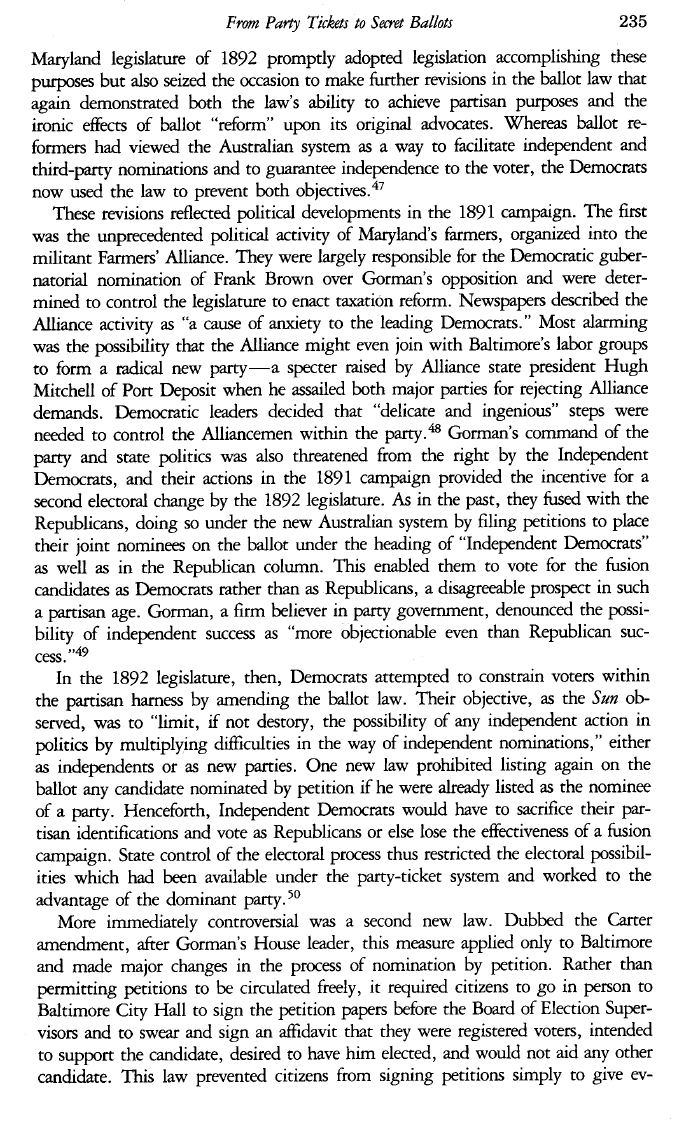|
From Party Tickets to Secret Ballots 235
Maryland legislature of 1892 promptly adopted legislation accomplishing
these
purposes but also seized the occasion to make further revisions in the
ballot law that
again demonstrated both the law's ability to achieve partisan purposes and
the
ironic effects of ballot "reform" upon its original advocates. Whereas
ballot re-
formers had viewed the Australian system as a way to facilitate independent
and
third-party nominations and to guarantee independence to the voter, the
Democrats
now used the law to prevent both objectives.4'
These revisions reflected political developments in the 1891 campaign. The
first
was the unprecedented political activity of Maryland's farmers, organized
into the
militant Farmers' Alliance. They were largely responsible for the
Democratic guber-
natorial nomination of Frank Brown over Gorman's opposition and were deter-
mined to control the legislature to enact taxation reform. Newspapers
described the
Alliance activity as "a cause of anxiety to the leading Democrats." Most
alarming
was the possibility that the Alliance might even join with Baltimore's
labor groups
to form a radical new party-a specter raised by Alliance state president
Hugh
Mitchell of Port Deposit when he assailed both major parties for rejecting
Alliance
demands. Democratic leaders decided that "delicate and ingenious" steps were
needed to control the Alliancemen within the party. 18 Gorman's command of
the
party and state politics was also threatened from the right by the
Independent
Democrats, and their actions in the 1891 campaign provided the incentive
for a
second electoral change by the 1892 legislature. As in the past, they fused
with the
Republicans, doing so under the new Australian system by filing petitions
to place
their joint nominees on the ballot under the heading of "Independent
Democrats"
as well as in the Republican column. This enabled them to vote for the
fusion
candidates as Democrats rather than as Republicans, a disagreeable prospect
in such
a partisan age. Gorman, a firm believer in party government, denounced the
possi-
bility of independent success as "more objectionable even than Republican
suc-
cess. "49
In the 1892 legislature, then, Democrats attempted to constrain voters
within
the partisan harness by amending the ballot law. Their objective, as the
Sun ob-
served, was to "limit, if not destory, the possibility of any independent
action in
politics by multiplying difficulties in the way of independent
nominations," either
as independents or as new parties. One new law prohibited listing again on
the
ballot any candidate nominated by petition if he were already listed as the
nominee
of a party. Henceforth, Independent Democrats would have to sacrifice their
par-
tisan identifications and vote as Republicans or else lose the
effectiveness of a fusion
campaign. State control of the electoral process thus restricted the
electoral possibil-
ities which had been available under the party-ticket system and worked to
the
advantage of the dominant party. 50
More immediately controversial was a second new law. Dubbed the Carter
amendment, after Gorman's House leader, this measure applied only to
Baltimore
and made major changes in the process of nomination by petition. Rather than
permitting petitions to be circulated freely, it required citizens to go in
person to
Baltimore City Hall to sign the petition papers before the Board of
Election Super-
visors and to swear and sign an affidavit that they were registered voters,
intended
to support the candidate, desired to have him elected, and would not aid
any other
candidate. This law prevented citizens from signing petitions simply to
give ev-
|

